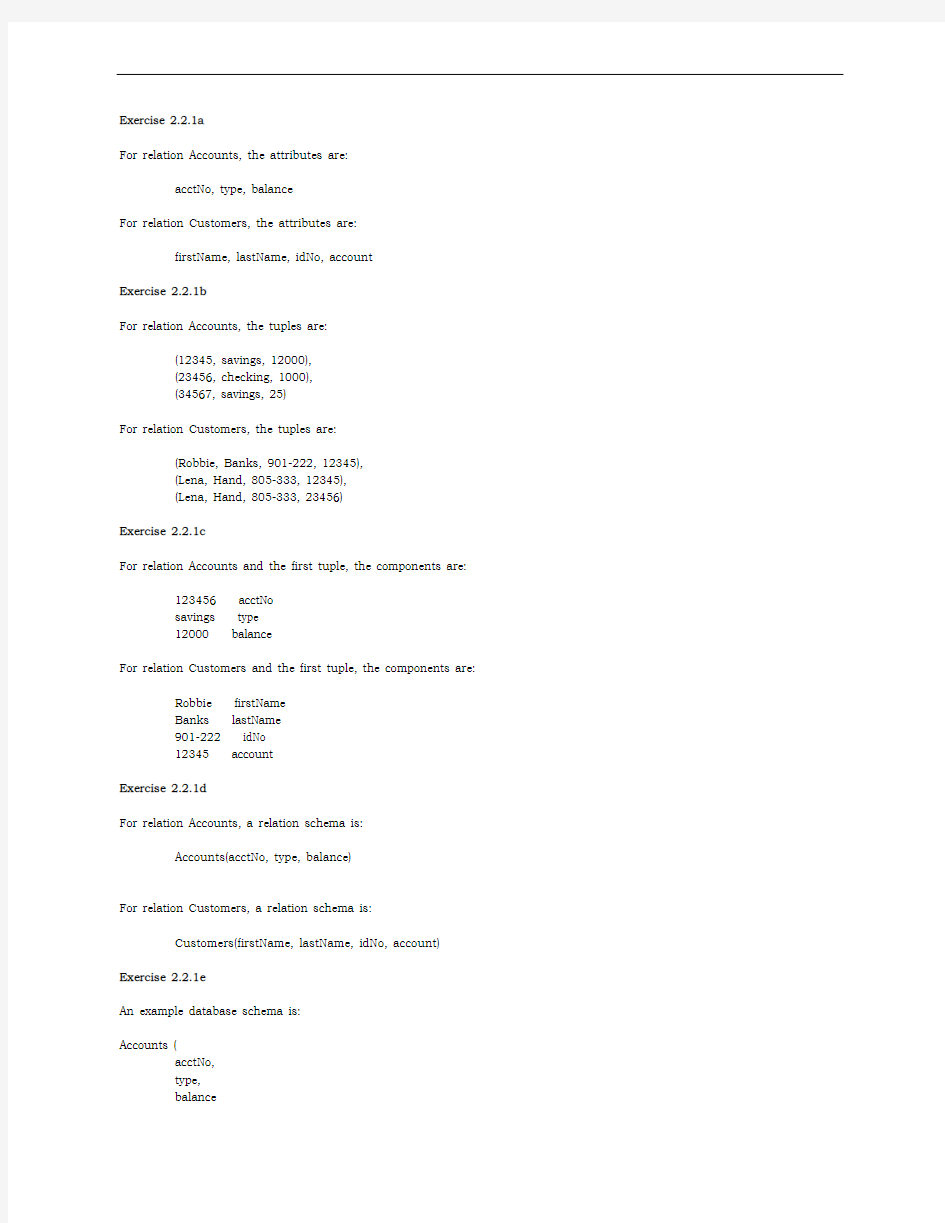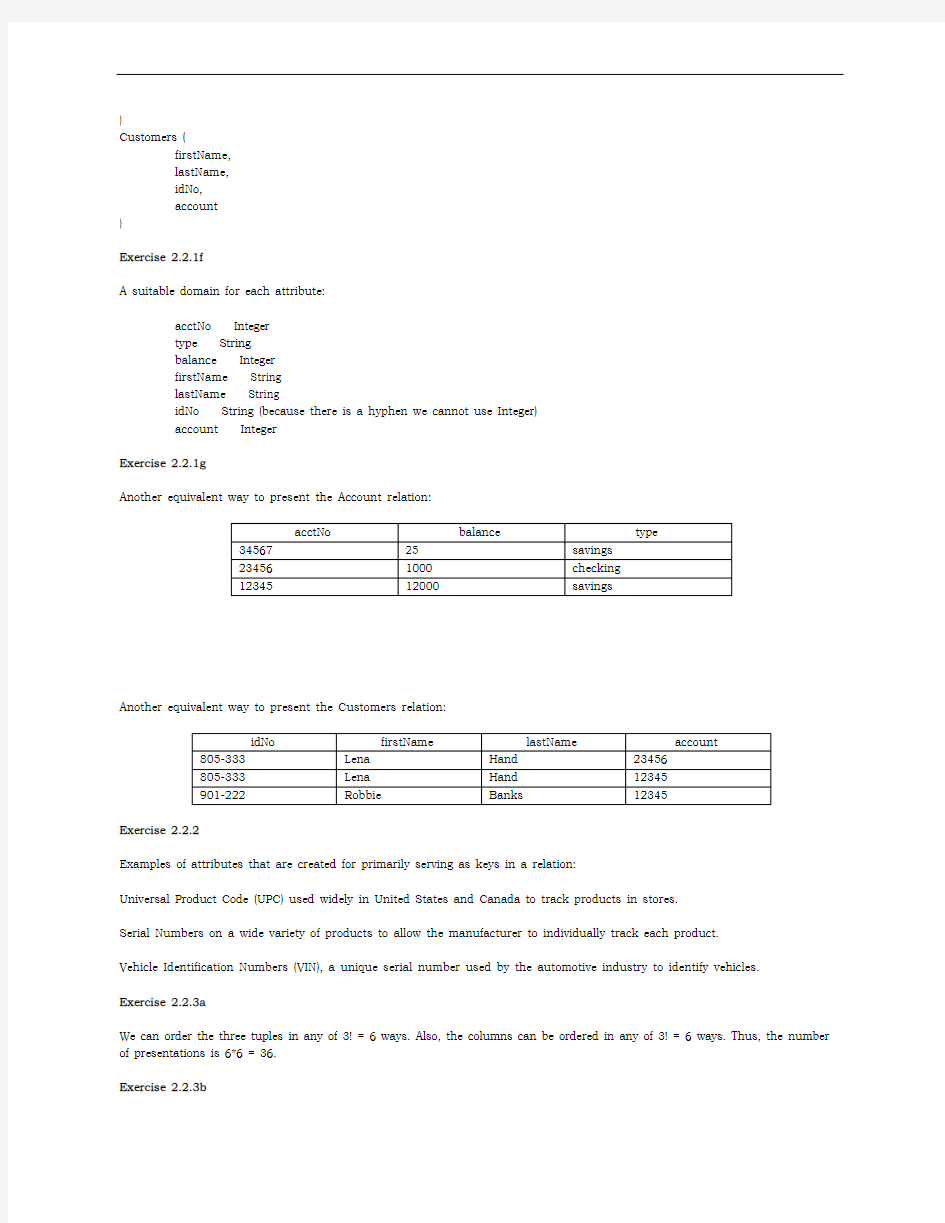

Exercise 2.2.1a
For relation Accounts, the attributes are:
acctNo, type, balance
For relation Customers, the attributes are:
firstName, lastName, idNo, account
Exercise 2.2.1b
For relation Accounts, the tuples are:
(12345, savings, 12000),
(23456, checking, 1000),
(34567, savings, 25)
For relation Customers, the tuples are:
(Robbie, Banks, 901-222, 12345),
(Lena, Hand, 805-333, 12345),
(Lena, Hand, 805-333, 23456)
Exercise 2.2.1c
For relation Accounts and the first tuple, the components are: 123456 acctNo
savings type
12000 balance
For relation Customers and the first tuple, the components are: Robbie firstName
Banks lastName
901-222 idNo
12345 account
Exercise 2.2.1d
For relation Accounts, a relation schema is:
Accounts(acctNo, type, balance)
For relation Customers, a relation schema is:
Customers(firstName, lastName, idNo, account) Exercise 2.2.1e
An example database schema is:
Accounts (
acctNo,
type,
balance
Customers (
firstName,
lastName,
idNo,
account
)
Exercise 2.2.1f
A suitable domain for each attribute:
acctNo Integer
type String
balance Integer
firstName String
lastName String
idNo String (because there is a hyphen we cannot use Integer)
account Integer
Exercise 2.2.1g
Another equivalent way to present the Account relation:
acctNo balance type
34567 25 savings
23456 1000 checking
12345 12000 savings
Another equivalent way to present the Customers relation:
idNo firstName lastName account
805-333 Lena Hand 23456
805-333 Lena Hand 12345
901-222 Robbie Banks 12345
Exercise 2.2.2
Examples of attributes that are created for primarily serving as keys in a relation:
Universal Product Code (UPC) used widely in United States and Canada to track products in stores.
Serial Numbers on a wide variety of products to allow the manufacturer to individually track each product.
Vehicle Identification Numbers (VIN), a unique serial number used by the automotive industry to identify vehicles.
Exercise 2.2.3a
We can order the three tuples in any of 3! = 6 ways. Also, the columns can be ordered in any of 3! = 6 ways. Thus, the number of presentations is 6*6 = 36.
Exercise 2.2.3b
We can order the three tuples in any of 5! = 120 ways. Also, the columns can be ordered in any of 4! = 24 ways. Thus, the number of presentations is 120*24 = 2880
Exercise 2.2.3c
We can order the three tuples in any of m! ways. Also, the columns can be ordered in any of n! ways. Thus, the number of presentations is n!m!
Exercise 2.3.1a
CREATE TABLE Product (
maker CHAR(30),
model CHAR(10) PRIMARY KEY,
type CHAR(15)
);
Exercise 2.3.1b
CREATE TABLE PC (
model CHAR(30),
speed DECIMAL(4,2),
ram INTEGER,
hd INTEGER,
price DECIMAL(7,2)
);
Exercise 2.3.1c
CREATE TABLE Laptop (
model CHAR(30),
speed DECIMAL(4,2),
ram INTEGER,
hd INTEGER,
screen DECIMAL(3,1),
price DECIMAL(7,2)
);
Exercise 2.3.1d
CREATE TABLE Printer (
model CHAR(30),
color BOOLEAN,
type CHAR (10),
price DECIMAL(7,2)
);
Exercise 2.3.1e
ALTER TABLE Printer DROP color;
Exercise 2.3.1f
ALTER TABLE Laptop ADD od CHAR (10) DEFAULT ‘none’;
Exercise 2.3.2a
CREATE TABLE Classes (
class CHAR(20),
type CHAR(5),
country CHAR(20),
numGuns INTEGER,
bore DECIMAL(3,1),
displacement INTEGER
);
Exercise 2.3.2b
CREATE TABLE Ships (
name CHAR(30),
class CHAR(20),
launched INTEGER
);
Exercise 2.3.2c
CREATE TABLE Battles (
name CHAR(30),
date DATE
);
Exercise 2.3.2d
CREATE TABLE Outcomes (
ship CHAR(30),
battle CHAR(30),
result CHAR(10)
);
Exercise 2.3.2e
ALTER TABLE Classes DROP bore; Exercise 2.3.2f
ALTER TABLE Ships ADD yard CHAR(30); Exercise 2.4.1a
R1 := σspeed ≥ 3.00 (PC)
R2 := πmodel(R1)
Exercise 2.4.1b
R1 := σhd ≥ 100 (Laptop)
R2 := Product (R1)
R3 := πmaker (R2)
Exercise 2.4.1c R1 := σmaker=B (Product PC)
R2 := σmaker=B (Product Laptop) R3 := σmaker=B (Product Printer) R4 := πmodel,price (R1) R5 := πmodel,price (R2) R6: = πmodel,price (R3) R7 := R4 R5 R6
Exercise 2.4.1d R1 := σcolor = true AND type = laser (Printer)
R2 := πmodel (R1)
Exercise 2.4.1e R1 := σtype=laptop (Product)
R2 := σtype=PC (Product) R3 := πmaker (R1) R4 := πmaker (R2) R5 := R3 –
R4
Exercise 2.4.1f R1 := ρPC1(PC) R2 := ρPC2(PC) R3 := R1 (PC1.hd = PC2.hd AND PC1.model <> PC2.model) R2 R4 := πhd
(R3)
Exercise 2.4.1g
R1 := ρPC1(PC) R2 := ρPC2(PC) R3 := R1 (PC1.speed = PC2.speed AND PC1.ram = PC2.ram AND PC1.model < PC2.model) R2 R4 := πPC1.model,PC2.model (R3)
Exercise 2.4.1h R1 := πmodel (σspeed ≥ 2.80(PC )) πmodel (σspeed ≥ 2.80(Laptop)) R2 := πmaker,model (R1 Product) R3 := ρR3(maker2,model2)(R2)
R4 := R2 (maker = maker2 AND model <> model2) R3 R5 := πmaker (R4)
Exercise 2.4.1i R1 := πmodel,speed (PC) R2 := πmodel,speed (Laptop) R3 := R1 R2 R4 := ρR4(model2,speed2)(R3)
R5 := πmodel,speed (R3 (speed < speed2 ) R4) R6 := R3 –
R5
Exercise 2.4.1j R1 := πmaker,speed (Product PC) R2 := ρR2(maker2,speed2)(R1) R3 := ρR3(maker3,speed3)(R1) R4 := R1 (maker = maker2 AND speed <> speed2) R2
R5 := R4 (maker3 = maker AND speed3 <> speed2 AND speed3 <> speed) R3 R6 := πmaker (R5)
Exercise 2.4.1k R1 := πmaker,model (Product PC) R2 := ρR2(maker2,model2)(R1) R3 := ρR3(maker3,model3)(R1) R4 := ρR4(maker4,model4)(R1) R5 := R1 (maker = maker2 AND model <> model2) R2 R6 := R3 (maker3 = maker AND model3 <> model2 AND model3 <> model) R5 R7 := R4 (maker4 = maker AND (model4=model OR model4=model2 OR model4=model3)) R6 R8 := πmaker (R7)